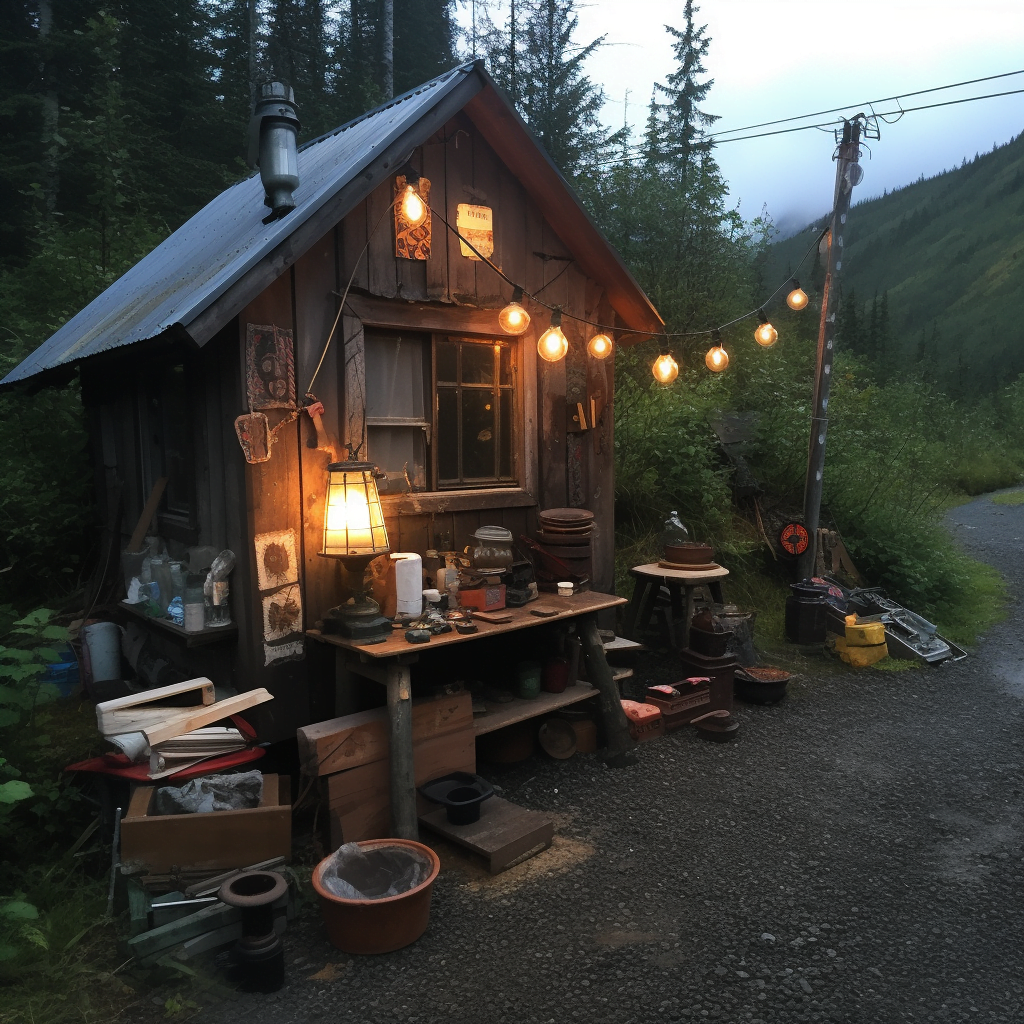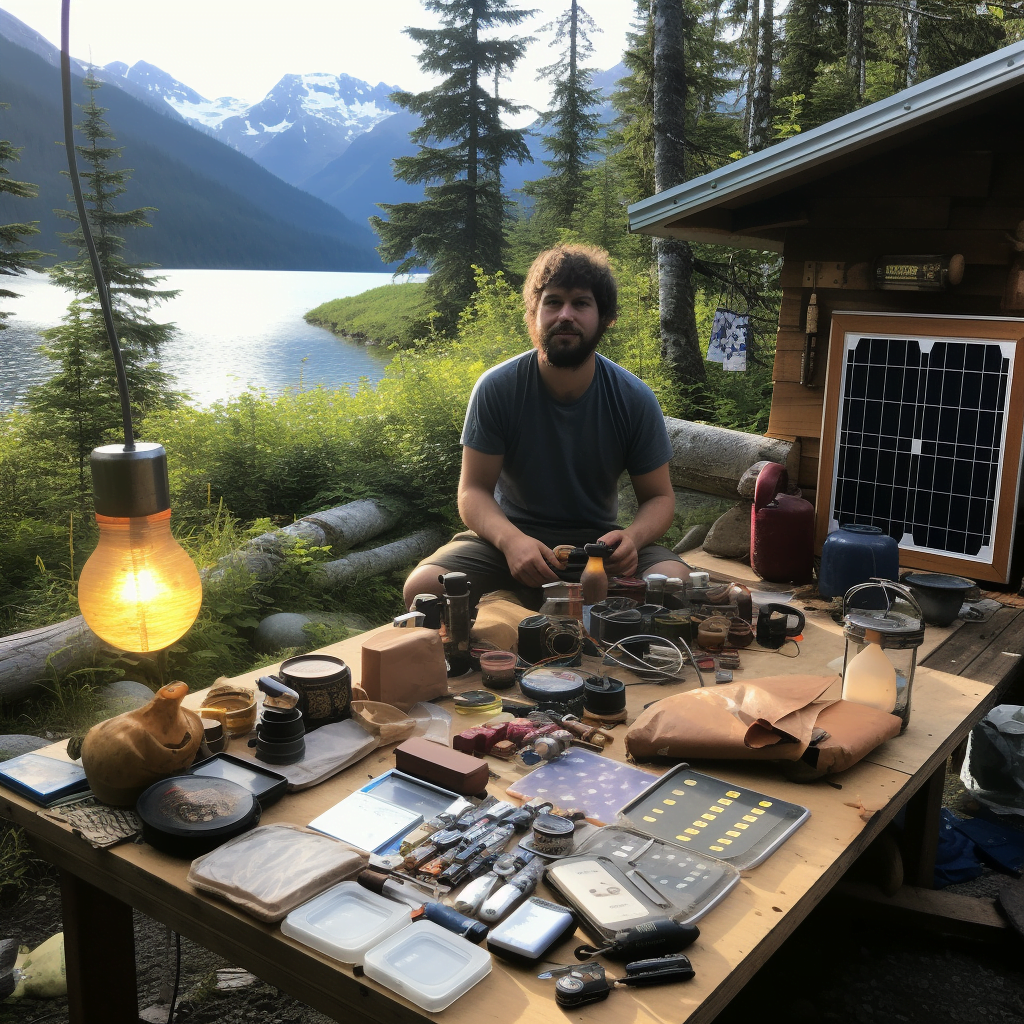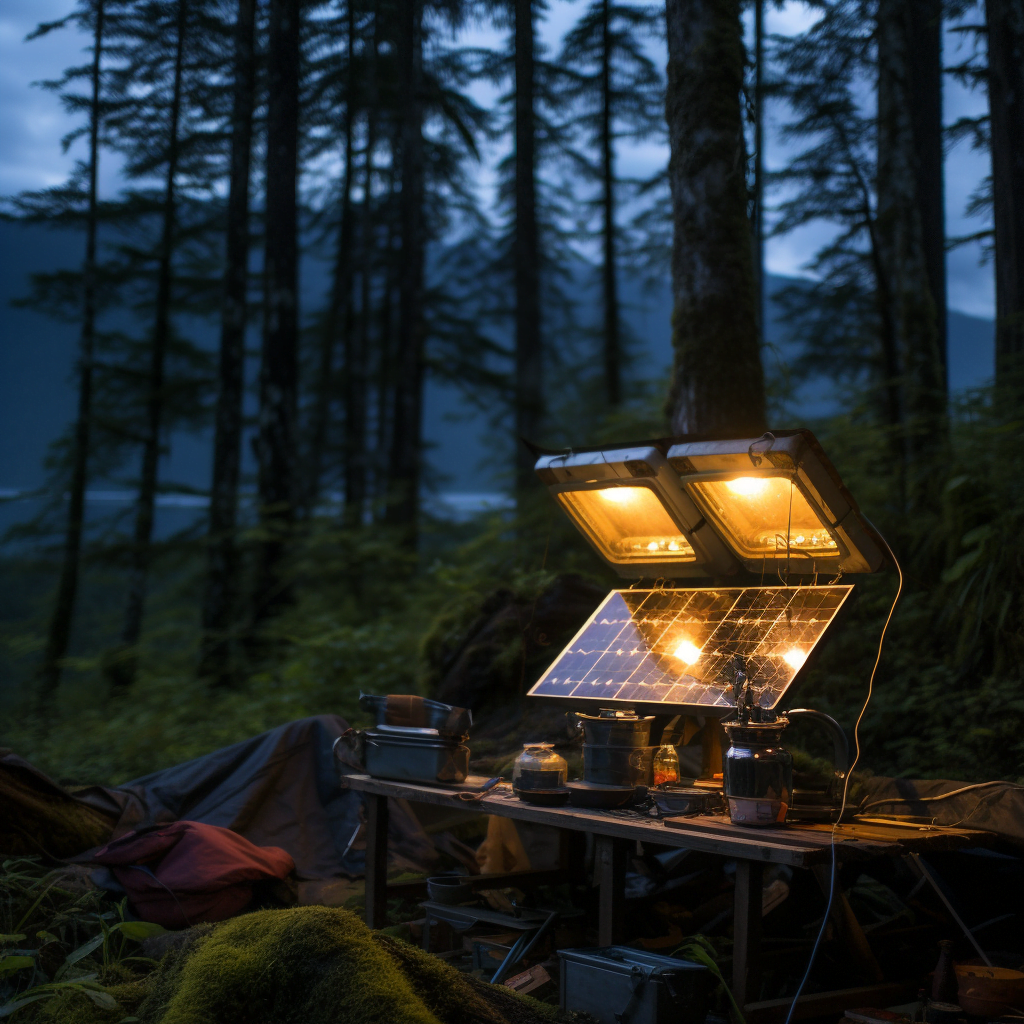Making the move to an off-grid lifestyle in Alaska can be an incredibly rewarding adventure. The rugged beauty and tranquility of living surrounded by pristine wilderness offers a level of freedom and sustainability that is hard to match. However, the long winter nights, frigid temperatures, and limited access to traditional power grids in remote areas present unique challenges when it comes to keeping an off-grid home reliably illuminated.
Having quality lighting is essential for daily tasks like cooking, reading, and getting around safely in interior spaces. Lighting also provides a fundamental level of comfort and normalcy during the extended dark nights. When transitioning to off-grid living, finding renewable, sustainable light sources you can depend on is a top priority. Carefully weighing the best lighting options for an off-grid home in Alaska is critical.
This article will explore various solutions, from classic oil lanterns to modern solar-powered lights, that can keep an off-grid Alaskan home illuminated year-round. The keys are evaluating your lighting needs, choosing equipment optimized for Alaska’s climate, taking advantage of renewable energy sources like solar and wind, and following vital safety and maintenance best practices. With the proper preparation and setup, Alaska’s long winters can be comfortably brightened using solar-powered lights, battery-powered LEDs, candle-fueled lanterns, generators, and various other off-grid lighting sources. Let´s answer the question ´When You Live Off Grid In Alaska What Do You Use For Light Source?´
Assessing Your Off-Grid Home’s Lighting Needs in Alaska
The first step when determining the best off-grid lighting setup is to assess your household’s specific lighting requirements and the ways different spaces will be utilized. Important factors to take into account include:
Calculate Total Number of Rooms Requiring Light
Make a comprehensive list of all rooms and spaces that will need lighting on a daily basis. This should include essential rooms like kitchens, bathrooms, living rooms, and bedrooms. But also factor in spaces like hallways, closets, basements, porches, and exterior outbuildings if they will be used routinely. Rigorously accounting for all areas that require light will give you an accurate overall picture of your lighting needs.
Consider Lighting Purpose Room-by-Room
Evaluate each room’s primary lighting purpose and lighting needs. Bright, focused task lighting is ideal for kitchen countertops where food prep will occur or work table areas. Ambient lighting may work better for bedrooms, hallways, and infrequently used storage closets. Think through how each room will be utilized and the lighting tone that would be most practical and comfortable.
Make a Room-by-Room Lighting Wattage Calculation
Add up the total wattage of lighting planned for each room based on its purpose. Average wattage guidelines per room:
- Kitchen: 300-400 watts to provide bright work area task lighting
- Living Spaces: 200-300 watts for reading or relaxed living
- Bedrooms: 100-200 watts for low lighting to move around safely
- Bathrooms: 50-100 watts for grooming tasks
- Utility Spaces: 50-100 watts for intermittent use
Tabulating the wattage by room provides a baseline for what your renewable energy system may need to produce to power your lighting needs.
Account for Alaska’s Seasonal Daylight Variations
When determining your lighting requirements, it’s crucial to factor in Alaska’s seasonal variations in daylight hours. During the peak summer months, you may have 20+ hours of ample natural daylight even in far northern regions. This can dramatically decrease the need for electrically powered indoor lighting during late spring, summer, and early fall.
But the long nights of winter are a different story. Areas like Barrow only average 4 hours of daylight at the winter solstice. Even Anchorage averages less than 6 hours of daylight in December. The further north your off-grid home is located, the more extreme the seasonal daylight variation. In the winter, your renewable energy system will need to account for powering lights for potentially 20+ hours per day – a significant increase from summer’s extended daylight availability.
So the takeaway when estimating your lighting needs is to calculate based on powering all essential lights for Alaska’s longest nights during winter months. This ensures your system can keep your home adequately illuminated year-round. Supplement plentiful summer sun with backups like battery storage to accommodate the challenges of winter’s minimal daylight.

Choosing the Optimal Off-Grid Light Sources for Alaska’s Climate
Once you’ve determined the scope of your off-grid home’s lighting requirements, the next step is selecting the right mix of light sources optimized for Alaska’s cold climate and remote locales.
Here are some of the most popular and reliable lighting options for off-grid homes in Alaska:
Solar-Powered Outdoor Lighting
Solar-powered lights are a robust, renewable lighting option well-suited for Alaska’s long summer days. Units like solar path lights, spotlights, string lights are easy “set and forget” lighting. Homeowners simply install and position the lights to maximize sun exposure. The integrated solar panel charges up a built-in battery during daytime hours. Once the sun sets, the light automatically turns on and provides hours of illumination throughout the night.
Pros
- Provide bright, free outdoor lighting without running electrical wires.
- Solar charges the battery so the units run sustainably night after night.
- Easy installation with no hardwiring required. Just position and let the sun do the work.
Cons
- Limited wattage and illumination area from small integrated solar panels.
- Output can be diminished on overcast winter days when sunlight hours drop drastically.
- Snow and ice buildup can impede solar recharging during winter.
Ideal Options
- Pathway marker lights
- Security spotlights
- Deck string lights
- Shed or garage work lights
- Rural driveway or yard pole lights
Battery-Powered LED Lights
Battery-operated LED lights offer versatility for indoor and outdoor lighting. They provide ample illumination while consuming a fraction of the power of incandescent bulbs. Many configurations are available, from compact flashlights and headlamps to lanterns and multi-light fixtures. Rechargeable versions can be powered up via USB for conservation.
Pros
- Widely available and affordable. Endless options for portable indoor/outdoor use.
- Highly energy efficient LED technology requires minimal power.
- Rechargeable versions mean you don’t have to constantly buy disposable batteries.
Cons
- Limited runtime per charge based on battery size and LED wattage.
- Batteries must be replaced or recharged regularly.
- Lack the larger-scale illumination of fuel or hardwired lighting.
Ideal Options
- AA/AAA Battery-powered LED flashlights and headlamps
- Battery-integrated LED lanterns and strip lights
- USB-rechargeable handheld lights and camping gear
Candle-Fueled Lanterns
Classic candle-powered lanterns burn lamp oil, beeswax, or other candle fuels to cast a warm, inviting glow. These simple devices have been lighting homes for centuries. Though not as bright as electric options, their flickering flames create ambiance and provide reliable supplemental lighting.
Pros
- Provide a warmer quality of light from burning candle flames.
- Fuel sources like lamp oil and wax candles burn slowly for weeks or months per refill.
- Rugged and reliable with few parts to break. Glass and metal designs are durable.
Cons
- Illumination is dimmer and more localized compared to modern lighting.
- Open flames present a fire hazard if tipped over or left unattended.
- Fuel can leak or spill if not handled carefully. Wicks require periodic trimming.
Ideal Options
- Tabletop oil lanterns
- Glass-enclosed beeswax candle lanterns
- Hanging multi-wick kerosene fixtures
- Old-fashioned railroad and miners lamps
Wood/Fuel-Burning Lights
Wood-burning and fuel-powered lighting like kerosene lanterns and propane lamps are common staples for off-grid living. Though not sustainable long-term, they can provide reliable illumination on just a small amount of lamp oil, diesel, propane, or other combustible fuel. Many classic designs burn for 8+ hours on a single tank.
Pros
- Burn cleanly and brightly on just a bit of fuel like kerosene or propane.
- Models with generators or pressurized fuel provide steady, robust light output.
- Portable and durable for indoor or outdoor use. Withstand tough conditions.
Cons
- Require proper ventilation due to carbon monoxide and fumes.
- Open flames present a tip-over fire hazard. Fuel requires careful handling and storage when flammable.
- Ongoing fuel purchase is not sustainable for primary long-term use.
Ideal Options
- Portable kerosene lanterns
- Propane-powered indoor/outdoor fixtures
- Diesel or gasoline generators with light hookups
- Pressurized gas hallway or ceiling

Generating Off-Grid Electricity for Lighting in Alaska
To power electrical lighting without relying solely on disposable batteries, you’ll need an off-grid renewable electricity system. Good options for power generation in Alaska’s challenging climate include:
Solar Photovoltaic Panels
Photovoltaic solar panels convert sunlight directly into usable DC current to power lights, appliances, devices, and tools. To determine how many solar panels your off-grid home needs:
- Calculate total lighting wattage required
- Factor in overcast/winter solar intermittency with a safety buffer
- Plan for additional electrical loads like appliances, pumps, etc.
- Size your system to meet daily needs even in the dead of winter
Position panels at optimal angles to maximize sunlight exposure in both summer and winter. Supplement panels with batteries to store surplus summer solar for winter usage.
Wind Turbines
Alaska ranks among the best locations in the U.S. for harnessing wind power. Small-scale wind turbines can effectively supplement solar, especially in the wind-swept rural areas ideal for off-grid living. Considerations when installing wind turbines:
- Research average wind speeds in your region. Areas along the coast and at high elevations tend to be better.
- Factor in obstructions like buildings, trees, or land contours that can impede airflow.
- Choose the appropriate size turbine for your power needs and wind resource.
- Elevate turbines on towers high enough to rise above obstructions.
Micro-Hydro Power
Micro-hydro systems utilize small creeks, streams, and rivers to generate renewable electricity. They divert flowing water through a turbine connected to a generator. Advantages of micro-hydro include:
- Generates continuous off-grid power day and night if sufficient water flow exists.
- Simple, time-tested technology with few moving parts to maintain.
- Allows taking advantage of small waterways without major environmental impact.
Consider micro-hydro systems if you have a reliably flowing water source on or near your property.
Gas or Diesel Generators
Generators offer a fallback for electricity when renewable resources are insufficient. But fuel costs, noise, and maintenance make them less ideal for continuous off-grid power.
Pros:
- Provide robust backup electrical power during cloudy periods or peak loads.
Cons:
- Require purchasing expensive, polluting fuel long-term.
- Loud operation. Models over 10kW require a separate shed or enclosure.
- Maintenance like oil changes required.
For a balanced system, use generators as supplemental backup rather than primary lighting power source.
Conserving Precious Off-Grid Energy
When living off-grid, energy conservation is a crucial part of the equation. Here are tips to minimize the power required to light your Alaskan home:
Use Efficient LED Light Bulbs
Switch all light fixtures to LED bulbs which require a fraction of the electricity of traditional incandescents. This cuts lighting power needs dramatically.
Install Timers and Motion Sensors
Adding timers or motion detectors ensures lights only activate when needed. This prevents accidentally leaving them on when not in use.
Leverage Summer Daylight
Maximize abundant natural daylight in summer by opening curtains and blinds and turning off unnecessary lights.
Follow a Strict Shutoff Routine
Make shutting off lights in unused rooms part of your daily routine to avoid waste.
Use Headlamps Instead of Overheads
For short tasks like laundry, a LED headlamp avoids powering up an entire room unnecessarily.
Choose Energy Star Appliances
When selecting appliances, electronics, and devices, choose Energy Star rated models for optimal efficiency. Reduce phantom loads with smart power strips.
Storing and Maintaining Off-Grid Lighting Fuels and Batteries
To keep fuel-based and battery-powered lighting options performing their best:
Store Fuels Properly
Gasoline, propane, diesel, kerosene, lamp oil and other combustible fuels should be stored properly in well-ventilated detached sheds or outbuildings in approved safety containers. Never bring them inside living spaces due to fire risk. Position far from ignition sources.
Follow Manufacturer Battery Guidelines
For lighting systems relying on replaceable batteries like rechargeable LED flashlights, or batteries coupled with solar panels, follow manufacturer guidelines to extend battery lifespan. Store in cool, dry locations and avoid exposing batteries to extreme cold or heat.
Monitor Fuel and Battery Levels
Meticulously track the fuel and battery levels of your various lighting systems and plan ahead for winter resupply when travel is most difficult. Never let supplies lapse into critical levels prior to winter.
Safely Dispose of Old Batteries
When replacing lead-acid batteries, bring expired ones to an approved hazardous materials recycling center to avoid soil and groundwater contamination on your property.
Remaining Vigilant About Safety
While incredibly useful, many common off-grid lighting options involve a degree of risk that requires vigilance. Practice exceptional safety with:
Fuel-Burning Lanterns and Lamps
Never bring fuel-burning lanterns that use propane, kerosene, lamp oil and alike indoors unless designed for indoor use with safety features like auto-off tilt switches and enclosed cases. Always allow for ample ventilation to avoid deadly carbon monoxide buildup.
Open Flames
Open flames from lanterns, oil lamps, candles, gas fixtures, etc. present a tip-over fire hazard if placed near flammable materials or left unattended. Make sure to extinguish fixtures before leaving an area.
Electrical Systems
Improperly installed wiring and cheap components can lead to dangerous malfunctions. Use surge protectors when connecting multiple lights and devices. Inspect for exposed wiring, frayed cords, loose connections and other red flags. Never overload circuits.
Fuel Storage and Handling
Exercise extreme caution when storing and dispensing flammable fuels, gases and chemicals. Ensure appliances, pipes, and tanks are in good condition with no leaks before use. Have proper fire extinguishers on hand. Never store or use fuels indoors.
Conclusion – Illuminating an Off-Grid Home in Alaska
Making the transition to a sustainable off-grid lifestyle in Alaska has many rewards. But finding ways to reliably light your home through the extreme winters and limited daylight is a major hurdle. The optimal solution is a balanced mix of lighting sources – from classic oil lanterns to modern LEDs – coupled with a properly sized renewable energy system.
With rigorous upfront planning and attention to factors like your lighting requirements, seasonal daylight variations, and safety best practices, an Alaskan off-grid home can be just as comfortable and welcoming as a conventional on-grid residence, even in the depths of winter. The right combination of candles, kerosene, batteries, solar panels, wind turbines and conservation makes evening reading, cooking dinner, or admiring mountain views equally enjoyable when living off the grid.
For many, the Alaska off-grid lifestyle offers a deeply fulfilling way to live more sustainably and self-sufficiently. Don’t let concerns about lighting hold you back. With creativity and commitment, reliable illumination during the long winter nights can be achieved. The beauty of Alaska under a starry winter sky lit gently by the glow of your off-grid home awaits.




